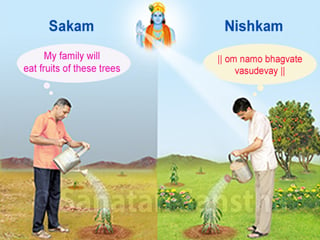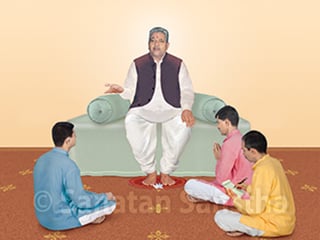In today’s Kaliyug (Era of strife), one who does not perform sadhana is like an animal; despite this knowledge about sadhana if one does not perform it, he is worse than an animal. If a sharp intellect is not supported by actual spiritual actions, then the life of the individual, despite being blessed with respect and honour is wasted.
This article explains the importance of human birth and purpose of life in context of performing sadhana. Only by the virtue of the human birth, one can leverage ones intellect to perform every activity as a sadhana, endure ones destiny, imbibe Divine qualities and progress spiritually.
1. In Kaliyug, the responsibility of increasing Sattva
component in the environment lies mainly on the human beings
In Satyayug, the ability of not just man but also of plants and animals to absorb Sattva waves on earth was high. They were sattvik (Sattva predominant), and Sattva particles too were emitted by them. As a result, the environment always remained sattvik. In the subsequent Yugs (eras), this ability of the people (to absorb Sattva waves) began to reduce; it is the least in Kaliyug. As against this, the ability of people to absorb Raja-Tama waves is increasing, due to which the environment has a higher proportion of Raja-Tama component. Among plants, animals (including birds) and human beings, only man possesses intellect. By performing sadhana with the intellect and absorbing Sattva waves, man has to shoulder the responsibility of increasing the Sattva component on earth. That is one of the purpose of life. Therefore, for man there is no alternative but to perform sadhana.
2. Benefits of performing sadhana on earth
when compared with other lokas (Subtle regions)
If a devotee can perform sadhana and attain Sayujyamukti in the same birth, why is it that Sages who have performed sadhana in the further lokas for thousands of years have not been able to merge with God ?
Sages in other lokas do not get the following benefits of performing sadhana as they would on earth.
-
Destiny can be expiated by undergoing it.
-
Sins and shadaripu can be destroyed.
-
Give-and-take accounts can be settled faster : Since the give-and-take accounts can be settled faster on earth, the spiritual level can increase faster. In other lokas, it is very difficult to increase the spiritual level since the opportunities to settle give-and-take accounts are far less when compared with that on earth. That is why, in each of the other lokas, people get trapped for thousands of years.
-
Sadhana is performed better when there is opposition : When compared with other lokas (from Swargalok to Satyalok), the opposition to sadhana is more on earth. When there is opposition, a seeker is reminded of sadhana more often, thus, enhancing it.
-
When compared with other lokas, sadhana performed on earth bears more fruit.
-
If sadhana is performed by creating a place in other lokas from earth itself, spiritual progress is faster.
When an individual begins sadhana on earth, based on the strength of the sadhana, except on earth, seats of the individual are created in other lokas. The more expansive the samashti sadhana of the individual, the more are the number of seats created. Due to these seats, based on the need, the individual’s subtle mission in the respective lokas continues. Consequently, the proportion of Gurukrupa (Guru’s grace) also increases, and the spiritual progress of the individual takes place faster. – His Holiness Dr. Jayant Athavale (Sanatan’s source of inspiration)
3. Developing interest in Spirituality
The individual who functions only for the self, provides help to others at the emotional level and begets 45% to 50% merits more than his sins, he begins to develop interest in Spirituality.
4. Commencement of sadhana
On an average, the spiritual level of a human being who takes birth on earth is 20%. He does not perform sadhana, since at that time he lacks the requisite ability. Subsequently, when he understands about sadhana, depending on his sanchit and prarabdha (Destiny), he uses his kriyamana (Wilful actions) to overcome all obstacles and commences sadhana.
5. Striking a balance between Spirituality
and worldly life is sadhana of supreme nature
Spirituality and worldly life are two sides of the same coin. Striking a balance between the two is sadhana of supreme nature. It is possible to perform worldly duties as sadhana, however, worldly life must not be brought into sadhana. That is why, those who perform sadhana with their worldly activities should perform these as sadhana. This will lead to fulfillment of worldly life and sadhana too will take place.
6. Importance of performing worldly activities as sadhana
A. Seekers can experience the quality of governance in the Divine Kingdom through their actions.
B. When one sees God in worldly activities, Chaitanya (Divine consciousness) appears there, and protects one from calamities.
C. One can continuously experience sadhana taking place in worldly life.
D. Attitude of sadhakatva (Seeker’s qualities) develops.
E. Once sadhakatva develops, the process of ‘wherever the seeker goes, sadhana is performed’ continues. As a result, seekers stop thinking that their sadhana has ceased while performing a particular action at a particular place or when visiting relatives.
7. Stages in sadhana
When an individual performs sadhana based on mental strength with the help of appropriate actions, he fulfills his duties.
A. Experiencing unmanifest bhav (Spiritual emotion) and an increase in inner Chaitanya
As the sadhana of an individual increases gradually, he experiences unmanifest bhav. In this process, instead of reactions the number of thoughts about Sat (Absolute Truth) increases. Hence, the Chaitanya within the physical body increases.
B. Chaitanya awakens the atmashakti (Soul energy).
C. The Gurutattva (Guru Principle) in the form of a flame guiding from within in the form of thoughts
Due to awakening of atmashakti, the subtle vibrations emitted by the physical body assume the form of a radiant flame and show the individual the path to God. Then, the flame (the Guru) guides the individual from within in the form of thoughts. This itself is referred to as ‘guidance of the Gurutattva’.
That is how, the individual is able to function at the level of the chitta (Subconscious mind).
D. With the Guru’s grace, the ego reduces rapidly, and advait (Non-duality) is attained
With the Guru’s grace, the ego reduces rapidly, and the individual advances from Maya (The Great Illusion) to Brahman (God Principle), that is, to the formless God. This itself is known as ‘attaining non-duality from duality’. Attaining advait bestows the Anand (Bliss) of Mukti (Liberation).
8. Spiritual level, bhav and ego
A. The spiritual level depends on sadhana and sadhana depends on bhav.
B. Instead of analysing how high is bhav and spiritual level in sadhana, it is important to analyse how less is the ego
A seeker with low ego can spiritually progress 3% to 5% annually. This being the cause for God’s grace, he can attain Moksha (Final Liberation) in a shorter period, meaning, in sadhana it is more important to know how low the ego is instead of how high are bhav and spiritual level. To achieve this, it is necessary to make continuous efforts; only then can consistency be maintained in sadhana and rapid spiritual progress can be achieved.
C. A seeker with a high spiritual level and high ego
Seekers with a high spiritual level and high ego stagnate at the same level for many years.
D. Stagnation in sadhana due to ego
When ego becomes an obstacle, sadhana starts stagnating. Till there is ego, we will not be able to merge with God. When ego starts reducing, stagnation in sadhana starts coming to an end. Only by Guru’s grace, the ego is completely destroyed and stagnation in sadhana is completely overcome.
Reference : Sanatan Sanstha’s Holy text ‘Sadhana (Spiritual Practice)’


 How the path of sadhana (Spiritual path) created by God has changed over various Yugs (Eras)
How the path of sadhana (Spiritual path) created by God has changed over various Yugs (Eras) Why Nishkam sadhana is superior to Sakam sadhana ?
Why Nishkam sadhana is superior to Sakam sadhana ? Importance of performing sadhana under the guidance of a guru
Importance of performing sadhana under the guidance of a guru